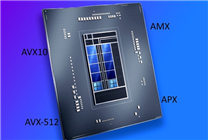### Key Highlights
– Intel’s upcoming Nova Lake processor may introduce new 512-bit instruction sets, potentially replacing AVX-512.
– Features like AVX10, APX, and AMX will enhance performance for AI, content creation, and encoding tasks.
– The Nova Lake architecture promises significant core advancements, expected to launch next year.
—
### Intel’s Next Move: The Future of the Nova Lake Processor
Intel has long been synonymous with innovative processing technologies, and the AVX-512 instruction set was once a hallmark of its prowess. However, following the rollout of its 12th generation Core processors featuring a hybrid “big and small core” design, AVX-512 has essentially been sidelined, remaining exclusive to the Xeon lineup. In contrast, AMD has taken strides in this area, offering a fully supported 512-bit variant.
#### Intel’s Future with AVX-512
There have been ongoing rumors about Intel potentially reintroducing AVX-512 support in future processors. However, as long as the hybrid architecture persists, the likelihood of this happening appears low. This does not imply that Intel is entirely abandoning its commitment to high-performance instruction sets. The company is exploring alternative technologies to maintain its competitive edge.
Recent updates to the NASM (Netwide Assembler) compilers, specifically versions 3.0 and 3.1, indicate that Intel’s next generation, known as Nova Lake, is poised to support a suite of new instruction sets. These include AVX10, APX, and AMX, which focus on accelerating 512-bit vector and matrix operations, providing a significant boost for content creation, encoding, decoding, and AI workloads.
#### What Does AVX10 Bring?
AVX10 can be considered a superset of AVX-512, encompassing all its functionalities while also being optimized for enhanced performance. Under this new framework, Intel’s P cores will support 512-bit vector calculations, while the E cores will be limited to 256 bits. Essentially, AVX-512 is being effectively replaced by this more advanced system.
#### Unpacking APX and AMX
APX, or Advanced Performance Extensions, represents a significant augmentation of the x86 instruction set, particularly in conjunction with AVX10. This synergy aims to enhance the efficiency of both large and small core architectures.
AMX, which stands for Advanced Matrix Extensions, is engineered specifically for deep learning applications, offering notable improvements in AI workload performance, building on features from AVX-512 and Intel’s DL Boost.
While these advancements have traditionally been reserved for Xeon processors, there is anticipation that Intel will deploy them across its Core architecture in a more decentralized manner. However, not every instruction will transition to the consumer level, as some may not yield substantial benefits for general use cases.
#### What to Expect from Nova Lake
The Nova Lake processor is projected to debut next year, bringing with it a robust architecture capable of supporting up to 52 cores. This includes 16 P cores, 32 E cores, and 4 LPE cores—resulting in impressive capabilities for both gaming and professional content creation.
As this technology evolves, Intel aims to solidify its standing in the processor landscape against competitors by introducing cutting-edge capabilities that meet the needs of a diverse set of applications.
### Conclusion
The impending release of the Nova Lake processor underscores Intel’s commitment to innovation and performance in next-generation computing. With the introduction of advanced instruction sets like AVX10, APX, and AMX, Intel is poised to redefine its impact on the industry. As we look forward to the official launch, it remains crucial for professionals and enthusiasts alike to keep an eye on these developments that promise to reshape the future of computing.









